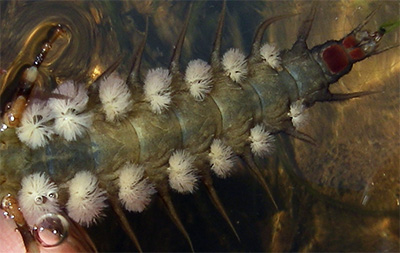|
Guided Fly Fishing in West Georgia FLINT RIVER SHOAL BASS - CHATTAHOOCHEE STRIPERS
LARGEMOUTH BASS & BREAM LAKES - GAR & CARP
|
|
|
Home Fishing Reports Locations & Species Tackle & Tactics Fly Box Guided Trips More |
|
|
Hellgrammites "meaty, beaty, big & bouncy..." Hellgrammites are the aquatic larval stage of the dobson fly and live three years before emergence. As they near maturity they crawl out of the water and burrow in the soil or decaying wood where pupation takes place. The adult dobson is a monstrous flying beast with a 4-6" wingspan. They are seldom seen as they emerge at dark, fly little and live only two or three days to deposit their eggs on limbs or rocks that overhang a current lane. Hellgrammites primarily burrow into weeds & gravel in search of prey, but are in the stream year-round and are often available to fish. And they are definitely a mouthful! On the Flint River, they are a favorite of the shoal bass and the bait fisherman. You can find them deep in the submerged grass and moss. If you wonder why the shoalies are often down in the rocks burrowing in the moss, this is the reason. The hellgrammite has short powerful legs plus gripping hooks on the last abdominal section. Mainly crawlers and clingers, they dive for the bottom when swept by the current. The hellgrammite has large lateral gill filaments, gripping hooks on the last abdominal section, and large biting mandibles on the head (and they will bite!). They are unusual in that although they are generally aquatic, taking in dissolved oxygen through abdominal lateral filaments and tracheal gills, they also have spiracles that allow them to take in air directly when above water. Often, "realistic" fly tiers try imitate the lateral filaments (see top photo) as they appear to be the most obvious feature of the bug. That is true when the hellgrammite is out of the water. Once in the water, however, the tracheal gills bloom and glow in bright white (see 2nd and 3rd photos). Though I have tied dozens of experimental flies attempting to imitate the fluffy white gills, a grizzly-hackled, black wooly bugger works at least as well. I weight the flies so they ride hook point up and fish them near the bottom on a dead drift.
|
|
|
C o n t a c t K e n t at kent@flyfishga.com or 7 0 6 - 8 8 1 - 3 2 4 9. | |


